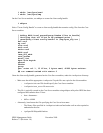where <group ID> can be obtained using the mount utility. The trace level can be changed while the
hpssfsd is running.
# echo 5 > /proc/fs/hpssfs/<group ID>/trace
• Show general information and statistics for a mounted file system:
# cat /proc/fs/hpssfs/<group ID>/info
• List files currently opened for a mounted file system:
# cat /proc/fs/hpssfs/<group ID>/opens
• List outstanding write requests for a mounted file system:
# cat /proc/fs/hpssfs/<group ID>/io
• List current requests to a daemon:
# cat /proc/fs/hpssfs/<group ID>/requests
14.5. Additional VFS Notes
14.5.1. Building an RPM Package
After setting up VFS on a machine, the admin can build a RPM package to distribute to other client
machines. The HPSS Client API must still be installed and configured on the target client.
Create/edit the file ‘hpssfs.spec’ to contain the HPSS VFS version number
For example:
Version: 6.2.1.10_%{_kversion}
Un-mount all VFS file systems first. Then...
$ make rpm
(newport: rpm is located in /usr/src/redhat/RPMS/i386/hpssfs-
6.2.2.0_2.6.9- 34.ELsmp.i386.rpm)
(rpm is located in /usr/src/redhat/RPMS/ppc64/hpssfs-
6.2.1.10_2.6.9-34.EL.ppc64.rpm)
(Make sure version no. is correct: hpssfs-6.2.1.10...)
HPSS Management Guide November 2009
Release 7.3 (Revision 1.0) 355


















